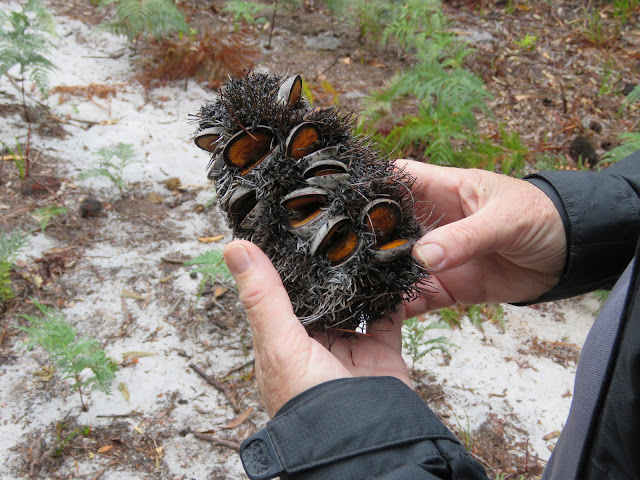We see-saw the Saw Banksia
The closest woodland with a pleasant walking track is most likely on the way to Millers Landing, at the north end of Wilsons Promotory. That's where we spent a pleasant morning back in late summer, and where I took these pictures of Banksia serrata.
From Wilsons Promotory, or thereabouts, the Saw Banksia grows naturally right up the east coast to southern Queensland. They also occur on Flinders Island, and at Rocky Cape on the very northern coast of 'mainland' Tasmania.
Most famously, the species grows around Botany Bay, where Sir Joseph Banks and Daniel Solander gathered it in April 1770. Later these specimens were used by Carl Linnaeus 'The Younger' (son of Carl Linnaeus who established the biological naming system we use today), to name and describe Banksia serrata, and three others species gathered from Botany Bay, in the genus named after Sir Joseph.
There are three other tree banksias in Victoria. The Coastal Banksia (Banksia integrifolia) extends a little further westward to Port Phillip Bay (with one isolated occurrence at Lower Glenelg River further west) and then also up the coast into Queensland. Silver Banksia (Banksia marginata) is scattered across the Victoria and into neighbouring states, including Tasmania (and ACT), while Rock Banksia (Banksia saxicola) is only found in the Grampians and Wilsons Promontory. All four grow at Wilsons Promontory.
On this walk you (or at least I) only see (saw) the Saw Banksia. And that's enough. It's a beautiful tree and I'm not surprised it appeals so much to Celia. The bark, leaves and fruits all have a certain something.
The coco-pop (a term used to describe the slightly more finely textured bark of the Wollemi Pine), corky bark helps this species survive fire. After six or seven years it is thick enough to survive at least some fires and re-shoot. The seeds are also released from the woody capsules, and germinate, after fire.
The flowers are not the most spectacular in the genus, but then none of the Victorian species are as brightly coloured as those in the west of the country.
So I recommend a visit to Celia's Gallery at Fish Creek (open Friday, Saturday and Sunday), followed by a short drive to Millers Landing to walk among the Banksia serrata. Then, if time allows, go off in search of the other three tree banksias in the Prom.
Images: The two herbarium specimens are from JSTOR and all other images are from my trip to Wilsons Promontory in the first week of February, 2019.









Comments
so I decided to give his herbal product a try. i emailed him and he got back to me, he gave me some comforting words with his herbal pills for Penis t, Enlargement Within 5 day of it, i began to feel the enlargement of my penis, ” and now it just 2 weeks of using his products my penis is about 10 inches longer and am so happy..feel free to contact DR OLU on(drolusolutionhome@gmail.com)or whatsapp him on this number +2348140654426